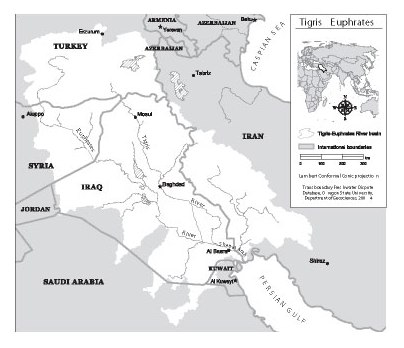Difference between revisions of "Case Study of Transboundary Dispute Resolution: the Tigris-Euphrates Basin"
From AquaPedia Case Study Database
| [checked revision] | [checked revision] |
Mpritchard (Talk | contribs) |
Mpritchard (Talk | contribs) |
||
| Line 9: | Line 9: | ||
|Water Project= | |Water Project= | ||
|Agreement= | |Agreement= | ||
| − | |REP Framework=[[File:Tigriseuphrates.jpg]] | + | |REP Framework=[[File:Tigriseuphrates.jpg]] Image 1. Map of the Tigris-Euphrates Basin<ref name= "Product of the Transboundary Freshwater Dispute Database, Department of Geosciences, Oregon State University. Additional information about the TFDD can be found at:http://www.transboundarywaters.orst.edu/research/case_studies/Tigris-Euphrates_New.htm </ref> |
| − | + | ||
|Issues= | |Issues= | ||
|ASI= | |ASI= | ||
Revision as of 11:59, 14 August 2012
{{Case Study |Geolocation=31.4048203, 46.9028375 |Population=20 |Area=789,000 |Climate=Semi-arid/steppe (Köppen B-type); Arid/desert (Köppen B-type); Humid mid-latitude (Köppen C-type) |Land Use=industrial use, urban- high density, religious/cultural sites |Water Use=Agriculture or Irrigation, Domestic/Urban Supply, Hydropower Generation |Water Feature= |Water Project= |Agreement=
|REP Framework= Image 1. Map of the Tigris-Euphrates Basin[1]
Image 1. Map of the Tigris-Euphrates Basin[1]- ^
|Issues=
|ASI=
|Key Questions=
|Summary=In 1975, unilateral water developments came very close to leading to warfare along the Euphrates River. The three riparian’s to the river- Turkey, Syria, and Iraq -had co-existed with varying degrees of hydropolitical tension through the 1960s. Bilateral and tripartite meetings, occasionally with Soviet involvement, had been carried out between the three riparian’s since the mid-1960s, although no formal agreements had been reached by the time the Keban and Tabqa dams began to fill late in 1973, resulting in decreased flow down-stream. In mid-1974, Syria agreed to an Iraqi request that Syria allow an additional flow of 200 MCM/yr. from Tabqa. The following year, however, the Iraqis claimed that the flow had been dropped from the normal 920 m3 /sec to an "intolerable" 197 m3 /sec, and asked that the Arab League intervene. The Syrians claimed that less than half the river's normal flow had reached its borders that year and, after a barrage of mutually hostile statements, pulled out of an Arab League technical committee formed to mediate the conflict. In May 1975, Syria closed its airspace to Iraqi flights and both Syria and Iraq reportedly transferred troops to their mutual border. Only mediation on the part of Saudi Arabia was able to break the increasing tension, and on June 3, 1975, the parties arrived at an agreement that averted the impending violence. Although the terms of the agreement were not made public, Iraqi sources are cited as privately stating that the agreement called for Syria to keep 42% of the flow of the Euphrates within its borders, and to allow the remaining 58% through to Iraq.
|External Links=
|Case Review=
}}



